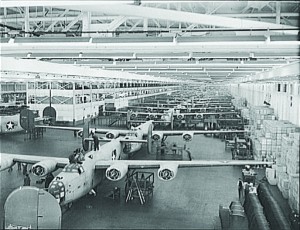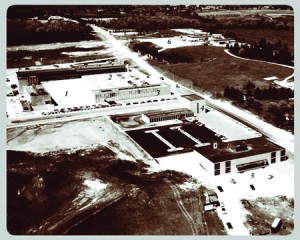Fall 1900
The first of the Aerospace program’s two founding members, Herbert Sadler, arrives at U-M to head Naval Architecture and Marine Engineering. His father was a balloonist, and he had a keen interest in aeronautics, though the area was too new to be respected as more than a hobby.
1911
Felix Pawlowski, pilot and possessor of the certificat d’etude of the University of Paris arrived in the U.S. in pursuit of his dream to be an aeronautical engineer. His efforts to obtain work at the Wrights’ factory in Dayton were unsuccessful, so he decided to apply for a post as a professor of aeronautical engineering. He wrote eighteen colleges and universities, most of which did not even reply to his fantastical proposal. Among the few that did were MIT and The University of Michigan. Only Michigan offered him a job. Dean Mortimer Cooley offered Pawlowski an $800-a-year appointment as Teaching Assistant in Mechanical Engineering with the promise that he would be permitted to teach a course in aeronautical engineering. The aero course was not to be offered for a year or so and it was to be a non-credit course, but Pawlowski was tempted enough by the offer to give up his job as truck designer in Toledo, Ohio—a job which probably paid a good deal more than the Assistantship-and move to Ann Arbor. (From Robert P. Weeks’s “The First Fifty Years”).
1913
Lucien Marchis visits the University of Michigan, and he and Pawlowski give a series of lectures some of which related to aeronautics. Thomas Adamson, Professor Emeritus of Aerospace Engineering, wrote “the appearance of a world-famous authority on an American campus strengthened the increasing academic respectability of aeronautical engineering in the country.”
1914
Dean Cooley approved the first credit courses with Theory of Aviation, taught by Pawlowski. It covered the basic principles of aerodynamics and flight mechanics as they are understood at the time.
1922
Ed Stalker becomes third faculty member, among first U-M Aero graduates in 1919.
1927
Immediately after Ludwig Prandtl’s new theory of lift was made available in the English language, Michigan Aero incorporated it into Theory of Aviation and added Mathematical Theory of Aerofoils to address advanced aspects. In the same year, inspired by Lindbergh’s flight, U-M Aero adds an Air Transportation course.
1928
Michigan Aero adds five graduate courses and begins a formal program for graduate research and advanced design.
1930
Completion of wind tunnel.
1941
Henry Ford and Charles Lindbergh built the world’s largest bomber facility at Willow Run in Ypsilanti. During peak production of the B-14 “Liberator” bomber, the plant employed 42,000 people including “Rosie the Riveter.” After the war, it served a brief stint as Detroit’s main airport.
1941–1945
With the onset of World War II, the Aero Department became geared to the war effort. Some faculty members joined the Armed Forces, others participated in the training of aircraft inspectors and pilots, and others engaged in applied research devoted to improving the design or manufacture of military aircraft. (From Robert P. Weeks’s “The First Fifty Years.”)
1946–1949
Professors Myron H. Nichols, Lawrence L. Rauch, and Robert M. Howe join the faculty, bringing expertise on instrumentation, advanced feedback control, missile guidance and radio telemetry.
1947
The University of Michigan buys Willow Run Airport from the federal government for $1, with the understanding that it will be operated as a research center. The new Michigan Aeronautical Research Center soon housed one of the first supersonic wind tunnels at a university, capable of producing a variety of speeds up to Mach 3.8, or 2.8 times the speed of sound. In addition to the wind tunnel studies, faculty and students performed upper atmosphere research, investigated defensive guided missiles in Project Wizard, and developed a guidance system for BOMARC nuclear anti-aircraft missiles. (Adapted from Robert P. Weeks’s “The First Fifty Years” and John Anderson’s “Riding the Crest”).
Mid 1950s
The Aerospace department moved to North Campus, to purportedly temporary buildings.
1965
The department changes its name from “Aeronautical and Astronautical Engineering” to “Aerospace Engineering.”
1968
Through the 1960s, a graduate-level program in instrumentation engineering grew out of the guided-missile-related courses, evolving into the Computer Information and Control Engineering (CICE) program. “CICE provided students with an integrated systems perspective that is now widely viewed as key to the development of many 21st century information technologies, including those that are essential to modern Aerospace enterprise,” said Harris McClamroch, a professor emeritus of aerospace engineering. CICE was dissolved in 1984.
1977
The University of Michigan sells Willow Run to Wayne Country for $1.
1979
Francois Xavier-Bagnoud enters the Aerospace Engineering program at U-M. Already a licensed pilot, he excelled in his studies and enjoyed the helicopter club. He went on to fly in over 300 rescue missions with his father’s company, Air Glaciers, in Switzerland and in Africa. At age 23, he was the youngest helicopter and airplane pilot in Europe certified to fly by instruments, allowing him to fly in poor visibility conditions. In 1986, covering the Dakar Rally (an off-road race from Paris to Dakar), the helicopter that Xavier-Bagnoud co-piloted with race organizer Thierry Sabine was swept up in a sudden sand storm over Mali and crashed into a dune, killing all on board. He was 24 years old.
1989
Since 1986, Aerospace Chair Thomas Adamson and Dean James Duderstadt flew many miles courting donors to help cover the cost of a new aerospace engineering building, capable of housing electronic and computer-driven instrumentation, with control over temperature and humidity. In 1989, the Countess Albina du Boisrouvray, mother of Francois Xavier-Bagnoud, pledged the department $5 million to help with the building, in memory of her son. She asked that the department start a center for helicopter studies, which began with the hiring of Peretz Friedmann. In addition, she created four complete fellowships for outstanding students. The FXB building remains one of the finest aerospace engineering buildings in the nation.





